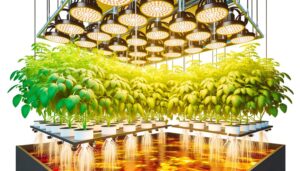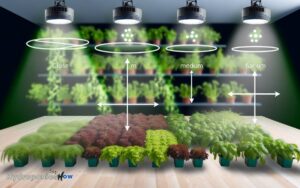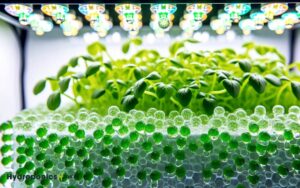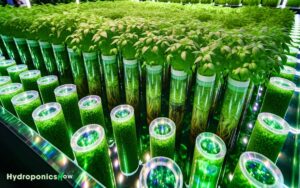10 Essential Steps to Prune Hydroponic Tomato Plants
Pruning hydroponic tomato plants involves strategic removal of lower leaves and suckers to enhance airflow and nutrient distribution. Use sterilized, high-quality pruning shears to prevent disease.
Begin pruning when plants reach 12-18 inches, removing non-productive leaves and yellowing foliage. Continue routine pruning every 1-2 weeks, guaranteeing proper airflow and light penetration.
Identify and remove suckers from leaf axils and consider topping plants to manage height and encourage lateral growth. Regularly inspect for signs of disease and monitor plant health metrics.
These practices will guarantee vigorous growth and a bountiful harvest. For detailed guidelines on each step, subsequent details offer deeper insights.

Key Takeaways
- Remove lower leaves to enhance airflow and reduce disease risk.
- Pinch off suckers regularly to direct energy towards fruit production.
- Prune yellowing or non-productive leaves for optimal light penetration.
- Begin initial pruning when plants reach 12-18 inches in height.
Understanding Plant Growth
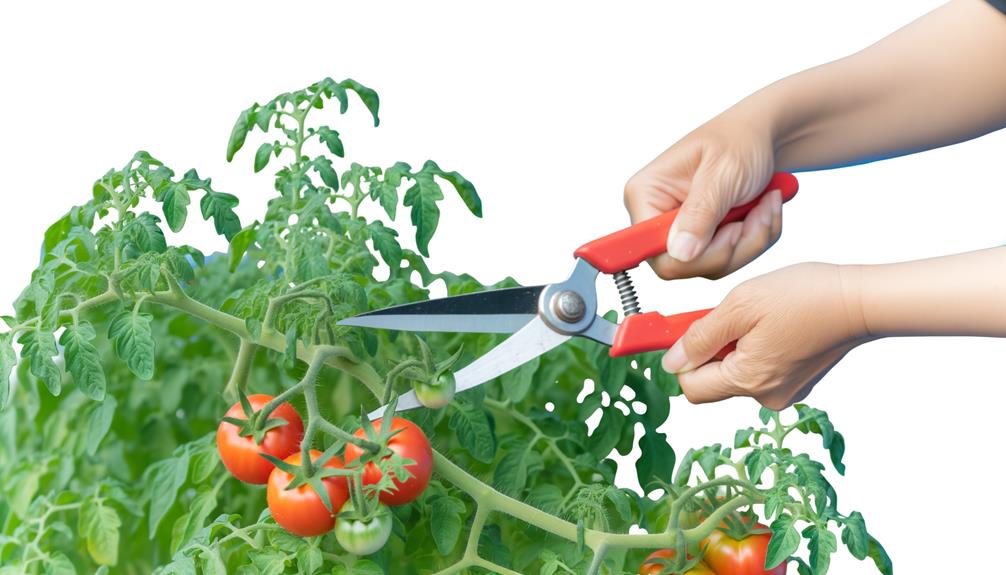
A thorough comprehension of plant growth stages is essential for effectively pruning hydroponic tomato plants, as it enables precise interventions that promote ideal health and yield. By understanding these stages, growers can determine the best times to trim excess foliage, ensuring that nutrients are directed toward fruit production rather than unnecessary vegetative growth. This knowledge also helps in managing factors like light exposure and airflow, which are crucial for disease prevention and optimizing yields. Additionally, recognizing the plant’s development cycle provides insight into how long hydroponic tomatoes last, allowing growers to plan harvests efficiently and maintain steady production.
Initially, during the vegetative stage, focus on removing lower leaves to enhance airflow and reduce disease risk.
As the plant shifts to the flowering stage, prioritize removing suckers—these are the shoots that emerge between the main stem and branches—to direct energy towards fruit production.
During the fruiting phase, eliminate any yellowing or non-productive leaves to optimize light penetration and nutrient distribution.
Understanding these stages allows for strategic pruning, which is vital for maintaining plant vigor, maximizing photosynthesis, and ultimately achieving a prolific harvest.
Tools You’ll Need
To effectively prune hydroponic tomato plants, specialized tools are imperative.
High-quality pruning shears are essential for making clean cuts that minimize plant stress and disease risk.
Additionally, a disinfecting solution is vital for sanitizing the shears between cuts to prevent cross-contamination and guarantee plant health.
Pruning Shears
Selecting high-quality pruning shears is essential for guaranteeing clean cuts and maintaining the health of your hydroponic tomato plants.
Opt for shears made from high-carbon steel or stainless steel, as these materials offer superior durability and rust resistance. Blades should be sharp and well-aligned to prevent crushing plant tissue, which can lead to disease.
Ergonomic handles with non-slip grips reduce hand fatigue during extended pruning sessions. Bypass shears are recommended over anvil types because they provide cleaner cuts.
Proper maintenance, including regular sharpening and cleaning, prolongs the lifespan of the shears and guarantees consistent performance.
Always choose shears that match the scale of your pruning tasks to optimize precision and efficiency in maintaining your hydroponic tomato plants.
Disinfecting Solution
Ensuring the health of your hydroponic tomato plants also requires the use of an effective disinfecting solution to sterilize your pruning shears between cuts. This practice mitigates the risk of pathogen transmission, which could compromise plant health.
A commonly recommended disinfectant is a solution of 70% isopropyl alcohol. To apply, immerse the blades of your pruning shears in the alcohol for at least 30 seconds, ensuring thorough contact.
Alternatively, a 10% bleach solution can be used, requiring a soak time of 10 minutes followed by a rinse with sterile water to prevent corrosion.
Consistently disinfecting your tools between cuts will maintain a sterile environment, safeguarding your plants from potential infections and promoting ideal growth conditions.
Identifying Suckers
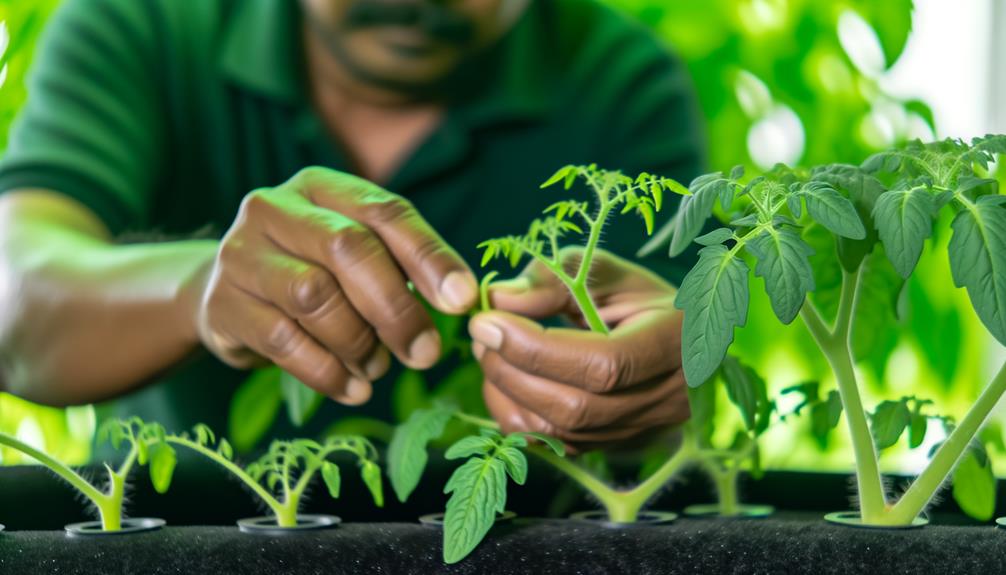
Suckers, which are the lateral shoots that emerge in the leaf axils of tomato plants, must be carefully identified and managed to optimize plant health and fruit production in hydroponic systems.
These shoots typically form at the junctions between the main stem and leaf petioles. Identifying suckers requires a discerning eye; they are smaller than the main stems but can rapidly grow and compete for nutrients.
Utilize precise observation to distinguish these from fruit-bearing branches. Their removal is essential to direct the plant’s energy toward the primary stem and fruit clusters.
Use sterilized pruning tools to prevent pathogen transmission.
Regular monitoring and early identification are vital for maintaining the balance between vegetative growth and fruit development.
Timing Your Pruning
The ideal timing for pruning hydroponic tomato plants is vital for maximizing fruit yield and ensuring robust plant health.
Initiate pruning when the plants reach 12-18 inches in height, typically around 4-6 weeks after transplanting. This stage allows for the identification and removal of the first suckers, which emerge in the leaf axils. Early pruning helps concentrate energy on primary stem development and fruit production.
Continue routine pruning every 1-2 weeks to manage new growth and maintain best plant structure. Avoid pruning during flowering and fruit set periods to prevent stress and potential yield reduction.
Adhering to this schedule facilitates consistent airflow and light penetration, essential factors for disease prevention and vigorous growth.
Pruning Techniques
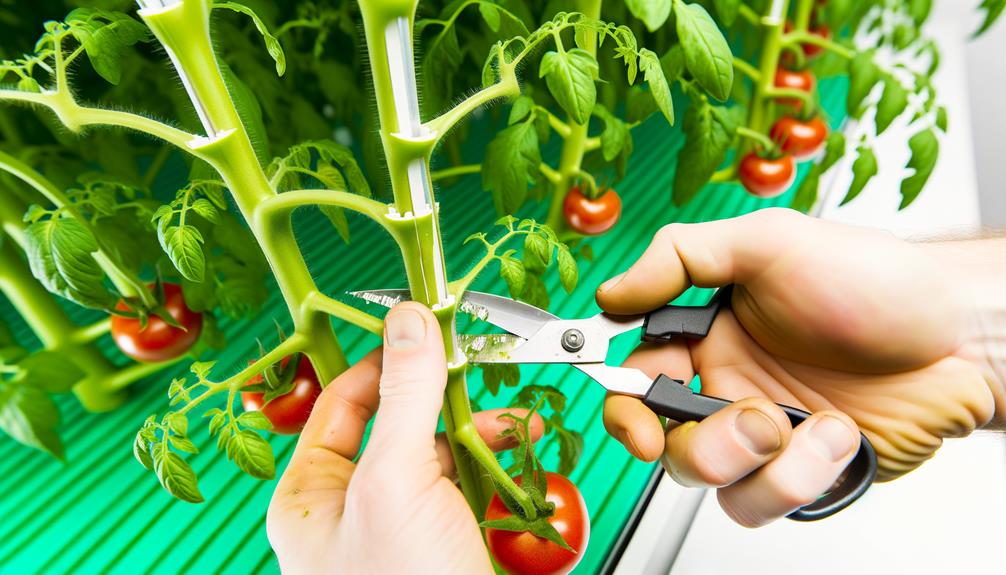
To effectively manage hydroponic tomato plants, implement specific pruning techniques that focus on removing unwanted growth and optimizing plant structure.
Begin by identifying and eliminating any suckers, which are the shoots that emerge from the leaf axils. These can divert essential nutrients from the main stem. Concentrate on maintaining a single or double stem system for better airflow and light penetration.
Key pruning techniques include:
- Pinching off suckers: Use clean, sharp tools to avoid plant stress.
- Topping the plant: Cut the main stem to control height and encourage lateral growth.
- Removing damaged foliage: Discard any yellowed or diseased leaves.
- Thinning dense clusters: Enhance light exposure by removing excess leaves.
Removing Lower Leaves
Removing lower leaves in hydroponic tomato plants is vital for preventing soil-borne diseases and enhancing nutrient allocation to the upper, fruit-bearing parts of the plant.
Begin by identifying the leaves below the first set of fruit clusters. Using sterilized pruning shears, carefully cut these leaves at their base, ensuring a clean cut to minimize the risk of infection.
This practice reduces the potential for pathogen transfer from the grow medium to the plant. Additionally, it optimizes the plant’s energy distribution, directing more nutrients to the developing fruits.
Regularly inspect the plant and repeat the process as it grows, maintaining a clear lower stem. This method is essential for maintaining plant health and maximizing fruit production in hydroponic systems.
Pruning for Airflow

Ensuring ideal airflow around hydroponic tomato plants is critical for preventing fungal diseases and promoting healthy growth.
Begin by removing dense foliage, especially in the central part of the plant, to enhance air circulation.
Additionally, trim the lower leaves that may obstruct airflow and create a humid microenvironment conducive to pathogens.
Remove Dense Foliage
Pruning dense foliage is essential for hydroponic tomato plants as it greatly enhances airflow, thereby reducing humidity and the risk of fungal diseases.
To achieve ideal ventilation:
- Identify Crowded Areas: Examine the plant for clusters of leaves obstructing light and air.
- Use Sterilized Tools: Employ clean, sharp pruning shears to prevent the spread of pathogens.
- Cut at the Node: Make cuts just above the node to promote healthy regrowth.
- Remove Suckers: Eliminate secondary shoots between the main stem and branches to direct energy towards fruit production.
Trim Lower Leaves
To enhance airflow and reduce the risk of soil-borne diseases, focus on trimming the lower leaves of hydroponic tomato plants. This practice improves ventilation around the base, diminishing fungal and bacterial threats.
Begin by identifying leaves below the first fruit cluster, as these are most susceptible to disease. Using sterilized, sharp pruning shears, carefully remove these lower leaves, ensuring cuts are clean to avoid plant stress.
Maintain a clearance of at least 12 inches from the growing medium to the first set of leaves. This promotes ideal airflow and light penetration, essential for robust growth.
Regularly inspect for any new growth in this lower area and continue pruning as needed to maintain plant health and maximize yield.
Managing Plant Height
Consistently managing the height of hydroponic tomato plants involves employing techniques such as topping and training to control vertical growth effectively.
Topping, the practice of removing the plant’s main growing tip, encourages lateral branching and maintains manageable height. Training involves guiding the plant using support structures to promote horizontal growth.
Key techniques include:
- Topping: Remove the main stem above a chosen node to prevent unchecked vertical growth.
- Training: Use trellises, strings, or cages to guide and support lateral growth.
- Pinching: Regularly pinch off new growth tips to limit height.
- Pruning: Remove unnecessary side shoots and suckers.
Implement these methods to achieve a controlled, productive hydroponic tomato crop.
Handling Fruit Clusters
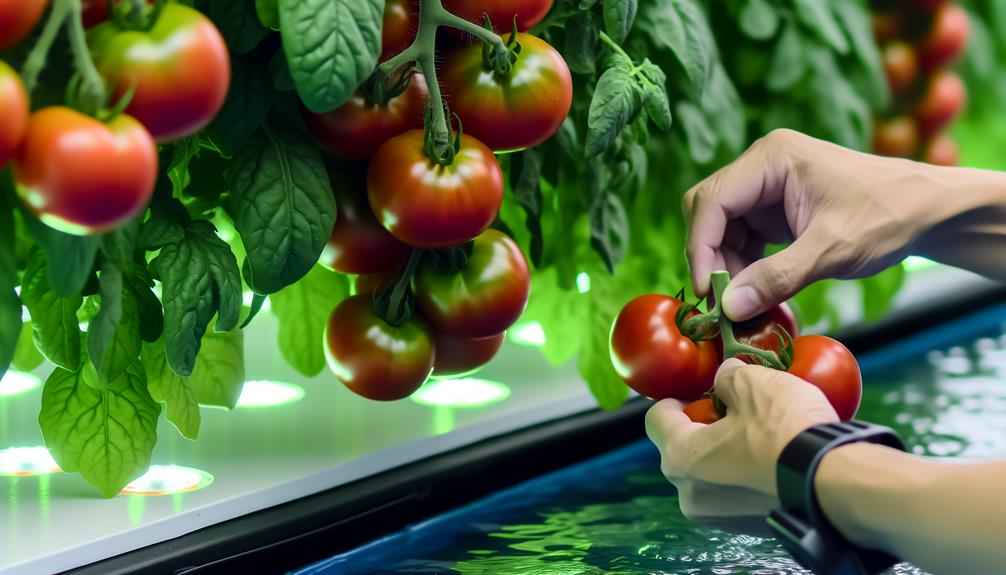
Managing fruit clusters in hydroponic tomato plants involves selectively thinning and supporting the clusters to enhance fruit quality and yield.
Begin by identifying clusters with excessive fruit set. Employ thinning techniques by removing smaller, less developed fruits, ensuring adequate spacing for remaining tomatoes. This promotes uniform growth and reduces competition for nutrients.
Utilize soft plant ties or tomato clips to support clusters, preventing stem breakage and ensuring even exposure to light.
Additionally, maintain a balance between vegetative growth and fruit production by pruning excess foliage that shades the fruit. This enhances air circulation and reduces the risk of fungal diseases.
Consistent monitoring and timely intervention are essential for maintaining ideal fruit development and maximizing overall yield.
Monitoring Plant Health
Ensuring ideal fruit clusters is only part of the process; vigilant monitoring of plant health is essential to sustain vigorous growth and prevent disease.
Regularly inspect the foliage, stems, and roots to identify any early signs of stress or infestation. Utilize Integrated Pest Management (IPM) strategies to control pests while minimizing chemical use. Implement a systematic approach to nutrient delivery and pH balance to enhance plant health.
- Inspect leaves for discoloration: Yellowing or spots may indicate nutrient deficiencies or disease.
- Check stems for lesions: Cracks or abnormalities can signal stem rot or fungal infections.
- Monitor root health: Healthy roots should be white and robust.
- Maintain ideal pH levels: Aim for a pH of 5.8-6.3.
Post-Pruning Care
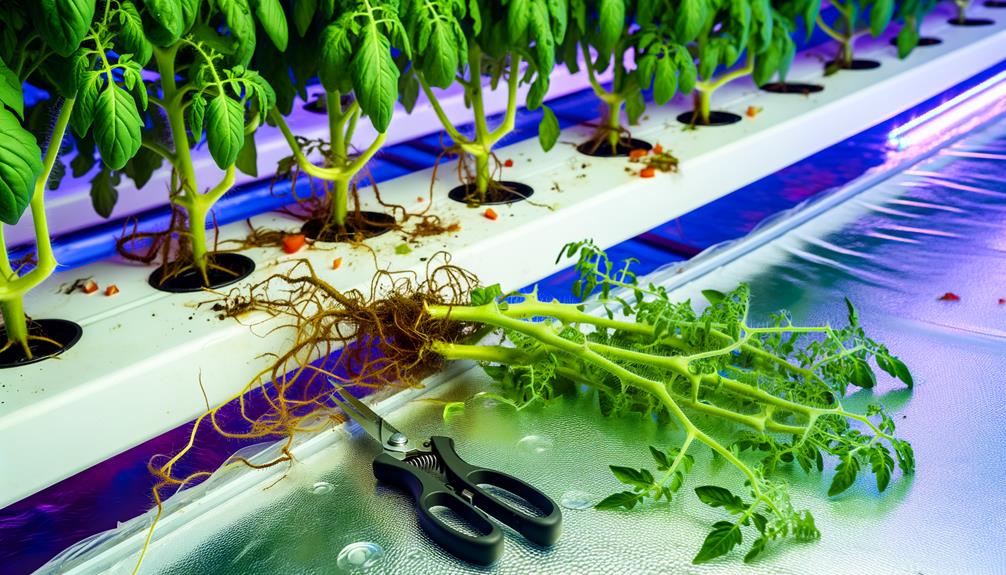
After pruning, it is vital to maintain ideal environmental conditions and nutrient levels to support the recovery and continued growth of hydroponic tomato plants.
Make certain that the nutrient solution is balanced with macro and micronutrients, maintaining an electrical conductivity (EC) of 2.0-3.5 mS/cm and a pH range of 5.5-6.5.
Keep ambient temperatures between 65-75°F (18-24°C) and provide 16-18 hours of light per day.
Monitor humidity levels, aiming for 60-70% to minimize stress.
Implement regular checks for disease and pests, as pruned plants are more susceptible.
Utilize clean pruning tools to prevent pathogen transmission.
Adequate ventilation is essential to prevent fungal growth; make certain airflow is consistent but not overly intense to avoid plant desiccation.
Conclusion
Effective pruning of hydroponic tomato plants has shown to increase yield by up to 30%, demonstrating the substantial impact of meticulous plant management.
Understanding plant growth stages, employing the correct tools, and executing precise pruning techniques at the appropriate times are critical elements.
Managing height, handling fruit clusters, and monitoring plant health guarantees robust development.
Post-pruning care further optimizes plant productivity, making pruning an indispensable practice in hydroponic tomato cultivation.

